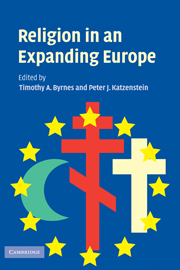Book contents
- Frontmatter
- Contents
- List of contributors
- Preface
- 1 Multiple modernities as limits to secular Europeanization?
- Part I European settings
- Part II Catholicism
- 4 The old Church and the new Europe: charting the changes
- 5 Thy will be done: the Catholic Church and politics in Poland since 1989
- Part III Orthodoxy
- Part IV Islam
- Part V Conclusion
- References
- Index
4 - The old Church and the new Europe: charting the changes
Published online by Cambridge University Press: 22 September 2009
- Frontmatter
- Contents
- List of contributors
- Preface
- 1 Multiple modernities as limits to secular Europeanization?
- Part I European settings
- Part II Catholicism
- 4 The old Church and the new Europe: charting the changes
- 5 Thy will be done: the Catholic Church and politics in Poland since 1989
- Part III Orthodoxy
- Part IV Islam
- Part V Conclusion
- References
- Index
Summary
This chapter combines old and new themes in the study of religion and politics. The entire volume testifies to the rising interest in the academy and in government bureaucracies about the role of religion in world politics. Religious ideas, institutions, and communities have either stepped into or been pushed and pulled toward the center of world politics and the foreign policy of states. Many would argue they have always had an influence in these arenas, but have been ignored. But that is surely no longer the case. The analytical attention now centered on the role of religion reverses a long-term pattern which was rooted on the confluence of the end of the religious wars in Europe and the rise of the modern tradition of international politics. These two events of the seventeenth century yielded a conviction among scholars and statesmen that drawing firm boundaries between the role of religion and the realities of interstate politics was both prudent and necessary (Philpott, 2002). This conviction, forged in the brutal experience of religious conflict, became a premise of the study and the practice of modern diplomacy. In the last twenty years that premise has been challenged and found wanting.
The Church and world politics
This volume testifies to the broadly based conviction of scholars that the failure to analyze systematically the role of religion in world politics will yield both inadequate intelligence and bad policy on some of the world's most conflicted problems.
- Type
- Chapter
- Information
- Religion in an Expanding Europe , pp. 93 - 116Publisher: Cambridge University PressPrint publication year: 2006
- 9
- Cited by



